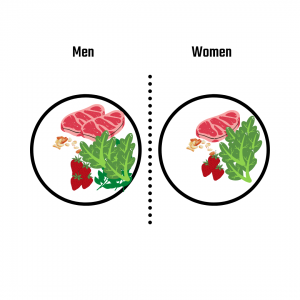Jul06Use This Simple Nutrition Hack Instead of Counting Calories
For most people, counting calories is the way to fat loss. It seems simple, right? Eat less calories = weight loss. But of course, human beings are not so simple; we are complex creatures. So what if there is a better method? That’s what we are exploring in today’s short post. In this, I’m going to go over the method of hand portioning, and how it can be helpful. But first, let’s talk about counting calories and why it may not be the best method.
The Problem With Tracking Calories
Tracking your calories works, there’s no argument there. It’s straightforward enough: the idea is to eat less than your maintenance threshold, which puts you at a deficit. Deficit = weight loss. So if you need 2400 calories everyday just to stay the same weight, eating 1,900 calories will be a daily 500 calorie deficit, which should mean 1 lb of weight lost every week. Simple enough, no?
The problem lies in the nature of it; For one, it’s quite tedious. Counting everything that you eat can be a chore, and mentally draining as well. It works, but for those that are more of a numbers-oriented type of person. Plus it turn food into numbers, and creates an unhealthy relationship with food (calories make me gain weight, calories are bad, food has calories, food = bad).
Another issue is sometimes people focus on just the calories, rather than the quality of food. You technically could eat only cookies and donuts and stay within your caloric goal and not lose weight, but it would be terrible for your health. You wouldn’t be getting vital macro and micro nutrients that are present in veggies, fruits, and lean sources of protein. You would even be hungrier, because you probably wouldn’t be getting enough satiating protein.
What then, would work best for most people who don’t have the time or energy to track every morsel? There is a very simple strategy, and it doesn’t cost a thing.
Hand Portioning
What is hand portioning? Well, it’s exactly how it sounds: using your hand as a measuring tool to portion out your food. It’s a system devised by Precision Nutrition, and it’s seemingly too simple and easy to be true, but it works.
The way it works is by using your hand (or parts of your hand) to portion out different food groups.
- the palm represents 1 serving of protein.
- a fist represents 1 serving of veggies.
- a cupped hand is 1 serving of carbs.
- the thumb is 1 serving of fats.
Using this model, you can easily build a balanced plate using your hand. There are many benefits to using this method. For one, the hand is portable, because it’s attached to you (hopefully) and you can take it anywhere. Whether you’re at a family cookout or out to dinner with some friends, your hand goes with you anywhere.
Two, it’s proportionate to your body; bigger people have bigger hands, smaller people have smaller hands. So you get the right serving size for your body. Bigger people typically need more food, and smaller people need less food.
So how do you use this method for yourself? Generally, men and women need different amounts.
Using this guide and assuming you are eating 3-4 times a day, the average man should have at each meal:
- 2 servings of protein at each meal.
- 2 servings of veggies at each meal.
- 2 servings of carbs at each meal.
- 2 servings of fats at each meal.
The average woman should have at each meal:
- 1-2 serving of protein at each meal.
- 1-2 serving of veggies at each meal.
- 1 serving of carbs at each meal.
- 1 serving of fats at each meal.
Below is an image of what it looks like on a plate.
Again, just a starting point, not a one-size-fits-all method. Some people are super active and need more food, and some people are not active and don’t need as much; maybe some women will need more food than men. The important thing when trying this is to stay flexible, and knowing when something isn’t working. If you use these recommendations and find that you aren’t losing or gaining weight (depending on your goals), then you can subtract or add a serving.
- If you’re trying to lose weight, subtract a serving of carbs or fats.
- If you’re trying to gain weight, add a serving of carbs or fats.
One more big reason why this is a great method: it makes you think of food as food groups, rather than numbers. Instead of seeing calories on your plate, you see portion sizes for each food group. If you follow this method correctly, you’ll be getting adequate protein, carbs, fats, and various vital micro nutrients. You’ll be eating for health, which is important for long term success.
Takeaway
This is not me saying that calorie counting is bad; it works for many people. But if you’re like most people, you don’t have the energy or the time to track every bite you put in your mouth. If that’s you, this quick guide on using your hand to portion out food can be extremely helpful. It’s easy to use, doesn’t require any equipment, and can be done anywhere. So if you’re tired of counting calories, give this method a try and see if it works for you; the power is truly in the palm of your hand!


